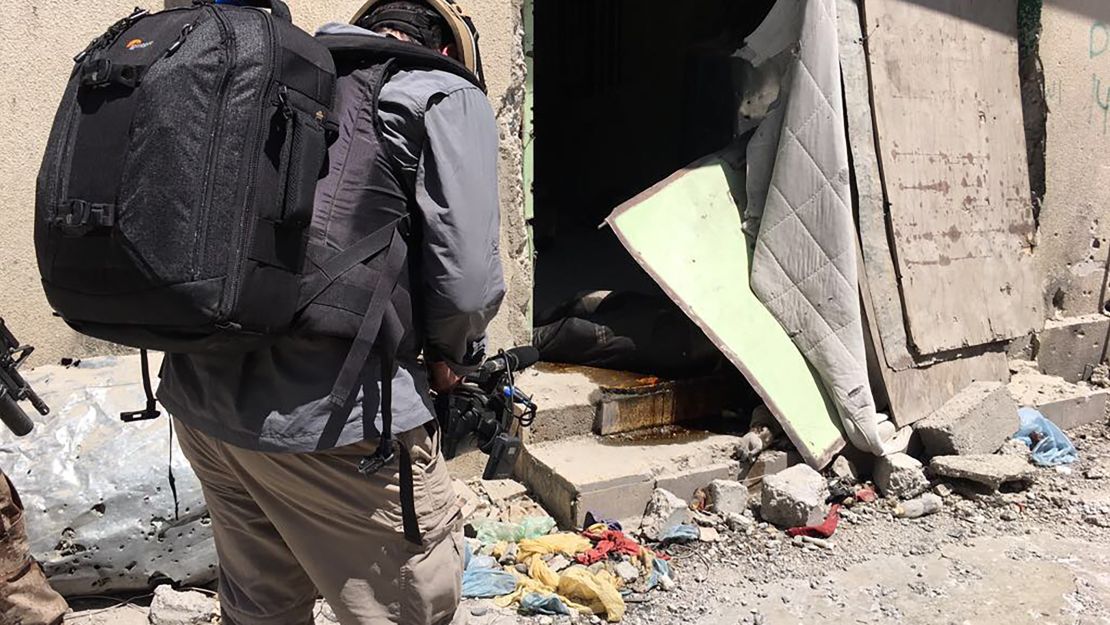What stands out most when you enter the Old City of Mosul is the smell.
It’s 110 degrees Fahrenheit (43 degrees Celsius), nearly every building is smashed to pieces and there is a constant thud of explosions. But all that fades into the background as the stench of death comes closer and closer.
“Look, there.” A guide from Iraq’s Counter Terror Force points to the body of an ISIS militant that lies where it fell.
The jihadi is blackened and bloated from days in the scorching sun. There are several more rotting corpses scattered in the rubble.

This is what is left of ISIS’ prize city in Iraq – festering dead, a few hundred yards of territory and about 200 diehard militants awaiting a final standoff.
Divisions remain strong
Senior Iraqi commanders took CNN inside the Old City in the calm before their final storm against ISIS.
On the rooftop of a villa now used as a forward operating base for Iraq’s Counter Terror Force, you see the consequences of ISIS’ scorched-earth policy.
There is the wreckage of the 12th century al-Nuri mosque and its huge, leaning minaret. The extremists blew it up about a week ago, according to the US-led coalition.
ISIS blamed the United States for the mosque’s destruction. While Iraqi forces may soon condemn ISIS to territorial defeat, it will not be possible to wash the mosque of the stain ISIS put upon it when leader Abu Bakr al-Baghdadi used it as the location to declare the caliphate.
Thousands have been killed in the fight to expel ISIS from Iraq, but little has been done to resolve the sectarian divisions that propelled the group’s rapid rise to power.
As the battle to recapture Mosul nears its final days, this clash of ideology will be the lasting legacy of this war.
Life returns
The resilience of the residents of Mosul who have been liberated from ISIS is clear.
Turn one corner away from the Old City, and normal life can be seen blooming between the pancaked buildings.
Men gather at outdoor cafes where waiters grill over open barbecues and the stench of death is mercifully replaced by the aroma of cooking. Families line the streets. Even in damaged buildings, people sip tea and chat.
War has reared its ugly head so often in Iraq’s recent history that the Muslawis, as the people of Mosul are known, have learned to adapt.
“I think it will be over for ISIS,” Major Salam Hussein of the CTS tells us. “But there has been terrorism of many kinds. We fought al Qaeda before. We fought Zarqawi before. These guys are different.”
Dozens of displaced families arrive at checkpoints leading out of Mosul, but – today, at least – not one is allowed to cross. Fears remain that fighters may try to escape along with civilians.
“My daughter is sick. Please, I want to take her to hospital,” a man begs the officer in charge. The soldier offers the distressed father water and rations, but he waves him away.

More and more dare to edge closer to the soldiers, until one soldier fires warning shots into the air. The crowd moves back, briefly, then approaches again. And again, shots are fired by the soldiers.
The routine goes on and on and is sure to repeat itself in the coming days.
Even if liberation is coming, there is still danger for residents, especially in the area still held by ISIS.
Civilians are ISIS’ last line of defense – likely to be corralled into lines of human shields as militants retreat, fight and perhaps try to escape.
How to help Iraqis fleeing Mosul
Iraqi forces may be planning the final assault, but peace is some distance away.

























